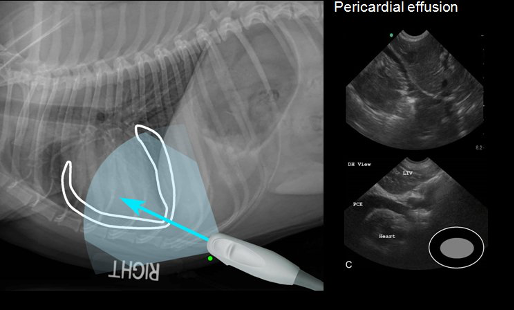Pericardial Effusion (PE) in Dogs (NAVLE Notes)
Pericardial effusion (PE) involves fluid accumulation in the pericardial sac, leading to cardiac tamponade and compromised heart function.
Classic Case
- Signs:
- Acute onset of weakness or collapse.
- Exercise intolerance, abdominal distention.
- Muffled heart sounds, tachycardia.
- Weak femoral pulses, jugular pulses.
- Pulsus paradoxus: Decreased pulse strength during inspiration.
- Pale mucous membranes.
Diagnosis

- Etiology:
- Cardiac Tumors: German Shepherd, Golden Retriever, Boxer, Labrador Retriever, Bulldog, Boston Terrier.
- Idiopathic PE: Golden Retriever, Labrador Retriever.
- ECG:
- Tachycardia and Low R-wave amplitude.
- Electrical Alternans: Alternating R-wave height due to the heart’s swinging motion within the fluid-filled pericardial sac (seen in 50% of cases).
- Radiography:
- Rounded, globoid cardiac silhouette.
- Dilated caudal vena cava and ascites.
- Echocardiography:
- Confirms a fluid-filled sac surrounding the heart.
- Signs of cardiac tamponade (right heart compression).
- Possibly detects causative mass in right atrium, right auricle, or heart base.
- Cytology of Effusion:
- Limited diagnostic value except in cases of lymphoma or infection.
- Effusion PCV < 10% may improve diagnostic yield.

Treatment
- Pericardiocentesis (ultrasound-guided):
- Performed between the 4th and 6th ribs at the right costochondral junction.
- ECG monitoring during the procedure to detect arrhythmias if the heart is accidentally contacted.
- Pericardectomy:
- For recurrent effusions to reduce tamponade risk.
- Can be curative in idiopathic cases.
- Treatment of Neoplasia:
- Right Auricular Hemangiosarcoma: Possible surgical resection.
- Lymphoma, Chemodectoma, Hemangiosarcoma, Mesothelioma: Chemotherapy options available.
Key Points
- Prognosis:
- Idiopathic PE: Generally favorable if effusions are infrequent or managed with pericardectomy.
- Neoplastic PE: Poor prognosis, especially with recurrent effusions or metastatic disease.
- Chemodectoma: Guarded prognosis; pericardectomy may extend survival.
- Ultrasonography:
- Diagnostic for PE and aids in identifying underlying causes, such as tumors.
- Feline PE:
- Often linked to heart failure, unlike in dogs.
NAVLE-Style Practice Questions on Pericardial Effusion
Question 1
A 7-year-old Boxer is presented with exercise intolerance, abdominal distension, muffled heart sounds, and weak femoral pulses. ECG reveals electrical alternans. What is the most likely diagnosis?
- A) Dilated cardiomyopathy
- B) Pericardial effusion
- C) Aortic stenosis
- D) Mitral valve disease
Correct Answer: B
Explanation: The presence of exercise intolerance, abdominal distension, muffled heart sounds, weak pulses, and ECG findings of electrical alternans strongly suggests pericardial effusion.
Question 2
An ultrasound-guided pericardiocentesis is performed on a dog with recurrent pericardial effusion. During the procedure, what is a critical aspect of monitoring?
- A) Serum electrolytes
- B) Oxygen saturation
- C) ECG to detect arrhythmias
- D) Blood pressure
Correct Answer: C
Explanation: ECG monitoring is essential during pericardiocentesis to identify arrhythmias that may occur if the needle contacts the heart.
Question 3
A Golden Retriever presents with signs of pericardial effusion. Echocardiography shows a mass on the right atrium. What is the likely prognosis?
- A) Good, with curative potential using antibiotics
- B) Poor, due to neoplastic origin
- C) Guarded, with prolonged survival possible with NSAIDs
- D) Good, with supportive care only
Correct Answer: B
Explanation: A mass on the right atrium in a dog with pericardial effusion often indicates a neoplastic origin, such as hemangiosarcoma, which has a poor prognosis.
For study notes visit cracknavle.com
Thanks for your tips. One thing I’ve noticed is always that banks and financial institutions know the spending practices of consumers and understand that plenty of people max outside their real credit cards around the trips. They correctly take advantage of this fact and start flooding a person’s inbox as well as snail-mail box together with hundreds of no-interest APR credit card offers just after the holiday season ends. Knowing that should you be like 98 of all American community, you’ll soar at the opportunity to consolidate card debt and shift balances towards 0 apr interest rates credit cards.
Comment awaiting moderation.